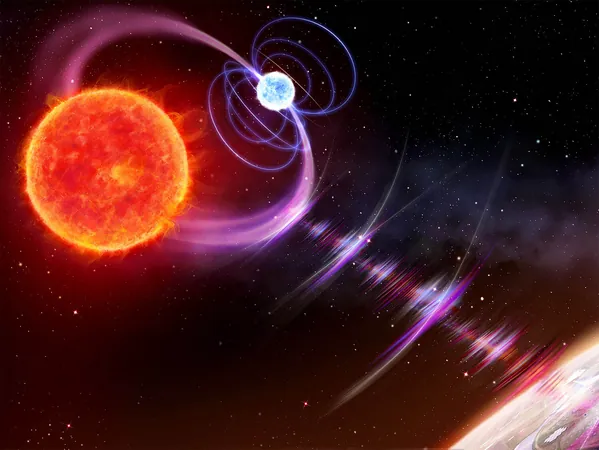
Cosmic Duo: Tiny Stars Unleash Mysterious Radio Signals in 125-Minute Dance
2025-05-16
Author: Jia
A Stellar Discovery to Remember
In an astonishing breakthrough, astronomers have detected unique radio signals emanating from a duo of stars—a white dwarf and a red dwarf—who orbit each other in just 125 minutes. This celestial choreography has left scientists buzzing with excitement!
Breaking New Ground: A Shift in Cosmic Understanding
Historically, neutron stars were the prime suspects for emitting such fascinating bursts of energy. However, this newfound discovery challenges that perception and opens the cosmic stage to other stellar bodies capable of generating these unusual signals.
Leading the Charge: Dr. Iris De Ruiter's Investigation
At the forefront of this research is Dr. Iris De Ruiter from the University of Sydney, who initially explored this phenomenon while completing her PhD at the University of Amsterdam.
Intriguing Radio Bursts Captured
The mystery began when astronomers analyzed data from the LOFAR telescope, known for capturing low-frequency radio waves. They identified that these stars intermittently emit short yet intense bursts of radio waves, precisely aligned with their extraordinary two-hour orbit.
Coordinated Cosmic Timing
Further investigations with prominent U.S. observatories, including Arizona's Multiple Mirror Telescope and Texas's Hobby-Eberly Telescope, confirmed LOFAR's findings. Remarkably, the data revealed that these radio pulses are intricately tied to the stars' orbital relationship—particularly noticeable when the red dwarf aligns behind the white dwarf from our viewpoint.
Understanding Dwarf Stars
But what exactly are these stars? The white dwarf is the dense remnant of a star that has exhausted its hydrogen fuel, often retaining a potent magnetic field. This could lead to intriguing interactions with its red dwarf companion, potentially igniting the radio surges that have piqued scientists' interest.
The Implications of Dwarf Star Signals
Experts believe these signals mirror interactions typically associated with highly magnetic neutron stars, thus breaking the notion that such phenomena are exclusive to a select group of celestial bodies. This discovery suggests many more binary star systems might be lurking in the cosmos, waiting to be uncovered.
Quest for More Cosmic Companions
With plans to explore the ultraviolet glow of this star system, researchers aim to unearth the temperature of the white dwarf and delve into the mechanisms behind these intense bursts. There's also the ambitious goal of revisiting older radio archives to unveil additional stellar pairs displaying these magnetic properties.
The Road Ahead: Unlocking Cosmic Mysteries
These findings bear immense significance—they not only expand understanding of where intense radio signals originate but also suggest that low-mass stellar systems might contain surprises that could reshape our cosmic explorations. The potential for hidden binary systems abundant in intense radio signals encourages collaboration among observatories globally.
Conclusion: A New Era of Discovery
The galaxy may indeed be rich with stellar partnerships demonstrating behaviors previously attributed solely to neutron stars. This cosmic twist could redefine the strategies astronomers use to locate exotic signals. As we continue to unravel the mysteries of the universe, the hunt for these extraordinary phenomena will accelerate.




 Brasil (PT)
Brasil (PT)
 Canada (EN)
Canada (EN)
 Chile (ES)
Chile (ES)
 Česko (CS)
Česko (CS)
 대한민국 (KO)
대한민국 (KO)
 España (ES)
España (ES)
 France (FR)
France (FR)
 Hong Kong (EN)
Hong Kong (EN)
 Italia (IT)
Italia (IT)
 日本 (JA)
日本 (JA)
 Magyarország (HU)
Magyarország (HU)
 Norge (NO)
Norge (NO)
 Polska (PL)
Polska (PL)
 Schweiz (DE)
Schweiz (DE)
 Singapore (EN)
Singapore (EN)
 Sverige (SV)
Sverige (SV)
 Suomi (FI)
Suomi (FI)
 Türkiye (TR)
Türkiye (TR)
 الإمارات العربية المتحدة (AR)
الإمارات العربية المتحدة (AR)